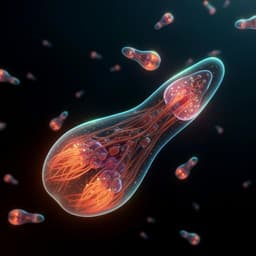
Engineering and Technology
Seamlessly merging radar ranging and imaging, wireless communications, and spectrum sensing for 6G empowered by microwave photonics
T. Shi, Y. Chen, et al.
Discover a groundbreaking photonics-assisted JRCSS system for 6G, revealing how radar, wireless communications, and spectrum sensing can seamlessly coexist. This innovative tech, developed by Taixia Shi, Yang Chen, and Jianping Yao, sets new standards in accuracy and efficiency.
~3 min • Beginner • English
Introduction
The paper addresses the need for 6G systems to integrate sensing (target/radar sensing and spectrum sensing) with high-speed wireless communications and AI to enable intelligent interconnection among people, machines, and things. Rather than deploying separate systems, integrating radar ranging and imaging, wireless communications, and spectrum sensing into a single joint system (JRCSS) can improve spectral efficiency, reduce hardware complexity, volume, and cost. However, conventional electronic implementations face bottlenecks in generating broadband, high-frequency complex waveforms with sufficient tunability and reconfigurability. Microwave photonics (MWP), offering large bandwidth, low loss, wide tunability, high frequency operation, and EMI immunity, is proposed as a promising enabler for such integration. The study’s purpose is to demonstrate a photonics-enabled unified architecture that simultaneously supports radar ranging and ISAR imaging, high-speed ASK-based communications, and wideband spectrum sensing with high accuracy, validating its feasibility for 6G scenarios.
Literature Review
The work builds on substantial advances in microwave photonics for single- and dual-function systems. Photonics-based radar has progressed since the first all-optical microwave photonic radar (2014), with later works integrating broadband LFM generation and optical-domain de-chirping to achieve high range and imaging resolution. Spectrum sensing via MWP maps frequency to power, space, or time. Frequency-to-power approaches struggle with multi-tone measurement alone; frequency-to-space approaches often require channelization; frequency-to-time mapping (FTTM) supports multi-frequency measurement and is implemented via fiber dispersion or swept optical carriers combined with optical filtering (e.g., SBS). Dual-function integrated systems include photonics-assisted joint communications-radar (JCR) and joint radar–spectrum sensing. Waveform sharing in JCR has used QPSK or spread-spectrum phase coding but typically requires high-rate sampling in radar receivers; ASK-LFM and QPSK-LFM with de-chirping reduce receiver complexity. Broadband LFM sources have been realized via photonic frequency doubling/quadrupling and optical injection. However, a single photonics-assisted system simultaneously performing radar ranging and imaging, wireless communications, and spectrum sensing had not been demonstrated, motivating the present unified JRCSS.
Methodology
System principle and architecture: A continuous-wave laser (LD) is split into two paths. One path feeds a dual-parallel Mach–Zehnder modulator (DP-MZM) driven by an intermediate-frequency (IF) ASK signal and a negatively chirped LFM signal with two designed phase relationships, implementing carrier-suppressed tandem single-sideband (CS-TSSB) modulation. This produces optical double sidebands on opposite sides of the optical carrier: one carrying the ASK, the other the LFM. The LFM optical sideband serves spectrum sensing; the beating of ASK and LFM sidebands after photodetection yields an RF ASK-LFM waveform for radar and communications.
- Spectrum sensing path: The CS-TSSB output is sent to an MZM, where an electrical signal-under-test (SUT) modulates the light with carrier-suppressed double-sideband modulation, leaving a partially suppressed carrier as a timing reference. The LFM sideband acts as a swept optical carrier. The probe then counter-propagates through a nonlinear medium (NM; single-mode fiber) against a pump from the other LD branch via a circulator, inducing stimulated Brillouin scattering (SBS) gain as a narrowband optical filter. As the LFM sweep traverses the SBS passband, time-domain optical pulses are generated at instants corresponding to the SUT frequencies (FTTM). A photodetector (PD1) and oscilloscope record the pulses; the SUT frequency f_SUT is estimated from pulse timing relative to the reference pulse using f_SUT = f_B × (t_sur − t_0)/T, where f_B is sweep bandwidth and T the sweep period. Time–frequency diagrams are obtained by aggregating successive sweeps.
- Radar and communications path: The other CS-TSSB branch is detected by PD2, producing an RF ASK-LFM signal via beating of ASK and LFM optical sidebands (centered at 10.8 GHz in experiments). For radar, one split drives a transmit antenna; echoes captured by a receive antenna are mixed with a local copy (self-LO) to generate a low-frequency de-chirped signal for range and ISAR imaging. For communications, a receive antenna captures the ASK-LFM; envelope detection is performed either by an envelope detector or by self-mixing with an RF coupler and mixer followed by low-pass filtering to recover data.
Signal generation and parameters: AWG1 generates two-phase-related versions of the ASK and negatively chirped LFM signals (1 Vpp each). LFM center 7.8 GHz, bandwidth 6 GHz, sweep period 4 μs. ASK center 3 GHz at 0.5 or 2 Gbaud. CS-TSSB at the DP-MZM places ASK and LFM on opposite optical sidebands. The ASK-LFM RF after PD2 exhibits spectrum broadening dependent on ASK baud rate; single-tone interferences arise from AWG and ASK harmonics.
Experimental setup (Methods): LD at 1553.096 nm, 16 dBm; DP-MZM (Fujitsu FTM7961EX; 7.5 dB IL); EDFA gain 16 dB; MZM (Fujitsu FTM7938EZ; 6 dB IL) driven by SUT from AWG2 (Keysight M8190A, up to 12 GSa/s; 1 Vpp, ~4 dBm). NM is 25.2 km SMF (SBS threshold ~7 dBm). PD1: Nortel PP-10G; PD2: u2t MPRV1331A. RF amplification: EA1 (5.85–14.5 GHz, 23 dB), EA2 and EA3 (5.85–14.5 GHz, 39 dB). Antennas: 8–18 GHz horns. Mixers: M/A-COM M14A (radar), Miteq m30 (comms). Oscilloscope sampling: 40 MSa/s for radar de-chirped, 10–100 MSa/s for spectrum sensing pulses, 10 GSa/s for comms self-mixing capture. The ASK-LFM center frequency is constrained by antenna and amplifier bands; LFM sweep set to 4.8–10.8 GHz; ASK IF at 3 GHz.
Compensation for uneven mixer response: The self-mixed communications waveform exhibits amplitude tilt versus time due to frequency-dependent link/mixer response. A temporal envelope is extracted, and inverse-amplitude compensation is applied to flatten the waveform before symbol decisions.
Tunability and extended sensing range: Center frequency of ASK-LFM can be tuned via ASK/LFM IF frequencies within hardware limits. Spectrum sensing measurement range is set by LFM optical sideband sweep and SBS gain position. A second DP-MZM (DP-MZM2) can perform optical carrier frequency shift via CS-SSB using a microwave signal generator, shifting the SBS pump and thus moving the sensing band from [0, 6] GHz to [f, f+6] GHz without altering the ASK-LFM generation.
Imaging and ranging protocols: ISAR with a rotating turntable (period 24.56 s), acquisition window 2.2 s at the farthest target angle; theoretical resolutions: range 25 mm (6 GHz LFM), cross-range 24.7 mm. Ranging tested for moving single cylinder (monitoring over rotation) and two stationary targets (range difference from de-chirped beat frequencies).
Key Findings
- Unified functionality: A single photonics-assisted system simultaneously performs radar ranging and ISAR imaging, wireless communications, and spectrum sensing using shared hardware and an optically merged ASK + LFM waveform.
- Communications: 2-ASK at 0.5 and 2 Gbaud demonstrated. After temporal envelope compensation, eye diagrams are open at both rates; 2 Gbaud achieves 2 Gbps. Self-mixing amplitude tilt due to frequency response is effectively mitigated via compensation. The system permits envelope detection alternatives for flatter response.
- Radar ranging and imaging: ISAR imaging of a cuboid and two cylinders yields clear separation of targets. Imaging resolution matches theory: range ~25 mm and cross-range ~24.7 mm. For moving target ranging (single cylinder), across 35 sampling points repeated 5 times, range measurements follow theory with errors ≤4 cm. For two stationary targets at separations 6.3–19.5 cm, de-chirped spectra show peak spacings corresponding to range differences with maximum deviation ~0.7 cm; de-chirped peak 3 dB bandwidth ~0.25 MHz (~2.5 cm resolution).
- Spectrum sensing (frequency and time–frequency): Using LFM optical sideband (6 GHz bandwidth, 4 μs sweep) and SBS FTTM, six tones between 1.0–2.0 GHz are measured 100 times with mean values within ±10 MHz and standard deviations of 4.8–7.5 MHz. Time–frequency diagrams are measured clearly for diverse SUTs: triangular-chirp LFM, “Sine” pattern, quadratic and quaternary NLFM, step-frequency 0.1–5.9 GHz (200 MHz steps), and an “ECNU” pattern. Sampling rate impacts frequency resolution: at 100–50 MSa/s, resolution is good; at 20–10 MSa/s, resolution degrades and lines merge for closely spaced tones (1.92 and 2.00 GHz). A frequency resolution of ~80 MHz is achievable at sufficiently high sampling and appropriate SBS bandwidth.
- Overall performance summary: Radar ranging error within ±4 cm; 2D imaging resolution 25 × 24.7 mm; communications at 2 Gbaud; spectrum sensing across 0–6 GHz with frequency measurement error within ±10 MHz and time–frequency analysis capability.
- Tunability: Center frequency can be adjusted via IF settings; sensing band can be shifted by SBS pump wavelength shift using an added DP-MZM2; ASK/LFM bandwidths can be traded to balance comms data rate versus radar precision.
Discussion
The integrated photonics-assisted JRCSS addresses the core 6G objective of fusing sensing with communications, achieving simultaneous radar ranging/imaging, high-speed data transmission, and spectrum awareness using a single waveform and shared hardware. Photonic CS-TSSB modulation enables clean placement of ASK and LFM on opposite optical sidebands, facilitating both RF ASK-LFM generation (for radar/comms) and an optical LFM sweep (for spectrum sensing via SBS-based FTTM). De-chirping in the RF domain reduces radar receiver complexity compared to high-rate ADC sampling of chirped echoes. Experimental results validate that communications at 2 Gbaud can coexist without materially degrading radar performance, and spectrum sensing obtains both frequency estimates (±10 MHz over 6 GHz) and clear time–frequency diagrams. System tunability is significant: center RF can be tuned by IF settings; sensing band can be relocated by shifting the SBS pump optical frequency, decoupling comms/radar centering from sensing range settings. Trade-offs are articulated: frequency resolution in sensing depends on chirp rate and SBS filter bandwidth; comms data rate and radar resolution share bandwidth resources and may require compromise under limited system bandwidth. Compared to separate implementations, the unified approach reduces hardware duplication and improves spectral efficiency, while offering broader bandwidth and reconfigurability than conventional electronics. A comparison with prior photonics-assisted systems underscores this as the first to seamlessly combine all three functions with competitive radar and the highest data rate (at microwave band) among multi-function approaches.
Conclusion
A photonics-enabled joint radar, wireless communications, and spectrum sensing system is demonstrated, using a single optically generated waveform comprising ASK and LFM sidebands. The LFM optical sideband drives SBS-based frequency-to-time mapping for spectrum sensing, while the RF beating of ASK and LFM sidebands supports de-chirped radar ranging/ISAR imaging and envelope-detected communications. Experimentally, the system achieves radar ranging error within ±4 cm, imaging resolution of 25 × 24.7 mm, 2-ASK communications at 2 Gbaud, and spectrum sensing over 0–6 GHz with ±10 MHz frequency error and ~80 MHz time–frequency resolution. The architecture offers tunability (center frequency, sensing band shift via SBS pump tuning) and can adapt bandwidth allocation between comms and radar. This unified approach is promising for 6G applications such as intelligent transportation, smart factories, and public security, enabling joint sensing and communications with reduced hardware duplication and enhanced spectral efficiency. Future work could focus on photonic integration to lower cost and size, improving link flatness for higher-order ASK or other modulation formats, expanding operational bands (e.g., mmWave/THz), and optimizing SBS bandwidth management for finer sensing resolution.
Limitations
- Hardware bandwidth constraints: RF components and antennas (8–18 GHz) and amplifiers (5.85–14.5 GHz) limit the ASK-LFM center frequency and usable sweep range.
- Uneven frequency response: Transmit/receive links and mixers exhibit frequency-dependent gain, causing amplitude tilt in self-mixed comms waveforms; compensation is required or flatter hardware/envelope detectors are needed.
- Modulation constraints: Only binary ASK is demonstrated; higher-level ASK would require improved SNR and flatter link response. Encoding phase on the LFM is incompatible with the simple de-chirping receiver used here.
- Spectrum sensing resolution trade-off: Frequency resolution depends on chirp rate and SBS filter bandwidth; with the intrinsic SBS linewidth and 1.5 GHz/μs chirp, resolution ~80 MHz is achieved. Lower sampling rates (≤20 MSa/s) degrade resolution and may merge closely spaced tones.
- Experimental components: Discrete, large-bandwidth opto-electronic components increase system complexity and cost compared to electronics; long SMF was used due to lack of highly nonlinear fiber, adding size/weight and setting SBS thresholds.
- Measurement range in demonstration: Sensing demonstrated over 0–6 GHz tied to LFM sweep and SBS shift; broader or shifted ranges require additional tuning (e.g., pump wavelength shift via DP-MZM2).
- Interference and spurs: Observed single-tone interferences from AWG and ASK harmonics; may affect spectral purity without additional filtering.
- Power considerations: SUT power can be low (down to −10 dBm with LNA), but SBS thresholds and link budgets constrain dynamic range.
Related Publications
Explore these studies to deepen your understanding of the subject.







